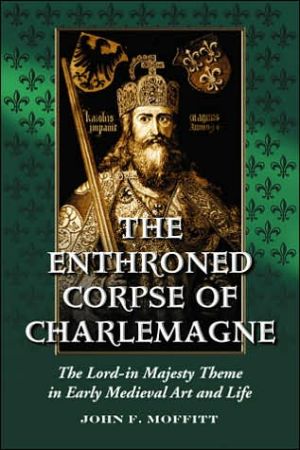

 |

|

Sold Out
Book Categories |
The corpse of Charlemagne was found in the year 1000 by the emperor Otto III, nearly two centuries after it had been hastily interred. All those present marveled at the corpse's striking appearance, for the revered emperor looked as though he were still living. Fully clothed in ceremonial garb and wearing his imperial crown, Charlemagne was found seated upright on a gilded chair; thus he appeared to the spectators in the then-conventional guise of a Maiestas Domini, or "Lord-in-Majesty."
This work focuses on a wholly new explanation for the dramatic appearance of Charlemagne's body by studying various historical traditions and cultural contexts (most largely unexplored by medievalists). The secular sources and applications of the persistent medieval theme of the Maiestas Domini are also explored. Chapters examine such topics as Charlemagne's legacy and its role in Alfred Rethel's mural paintings (Karlsfresken); the early medieval "Lord in Majesty" and the example of Saint Foy at Conques; Saint Foy as both an imperial effigy and an apocryphal figure; a study of Charlemagne and Constantine; Roman-Imperial funerary ceremonies with wax "body replicas"; contexts for and the meaning of Charlemagne's Karlsgrab; and the Carolingian and Ottonian "Lords-in-Majesty." Numerous illustrations are included.
Login|Complaints|Blog|Games|Digital Media|Souls|Obituary|Contact Us|FAQ
CAN'T FIND WHAT YOU'RE LOOKING FOR? CLICK HERE!!! X
 You must be logged in to add to WishlistX
 This item is in your Wish ListX
 This item is in your CollectionThe Enthroned Corpse of Charlemagne: The Lord-in-Majesty Theme in Early Medieval Art and Life
X
 This Item is in Your InventoryThe Enthroned Corpse of Charlemagne: The Lord-in-Majesty Theme in Early Medieval Art and Life
X
 You must be logged in to review the productsX
 X
 X

Add The Enthroned Corpse of Charlemagne: The Lord-in-Majesty Theme in Early Medieval Art and Life, The corpse of Charlemagne was found in the year 1000 by the emperor Otto III, nearly two centuries after it had been hastily interred. All those present marveled at the corpse's striking appearance, for the revered emperor looked as though he were still l, The Enthroned Corpse of Charlemagne: The Lord-in-Majesty Theme in Early Medieval Art and Life to the inventory that you are selling on WonderClubX
 X

Add The Enthroned Corpse of Charlemagne: The Lord-in-Majesty Theme in Early Medieval Art and Life, The corpse of Charlemagne was found in the year 1000 by the emperor Otto III, nearly two centuries after it had been hastily interred. All those present marveled at the corpse's striking appearance, for the revered emperor looked as though he were still l, The Enthroned Corpse of Charlemagne: The Lord-in-Majesty Theme in Early Medieval Art and Life to your collection on WonderClub |